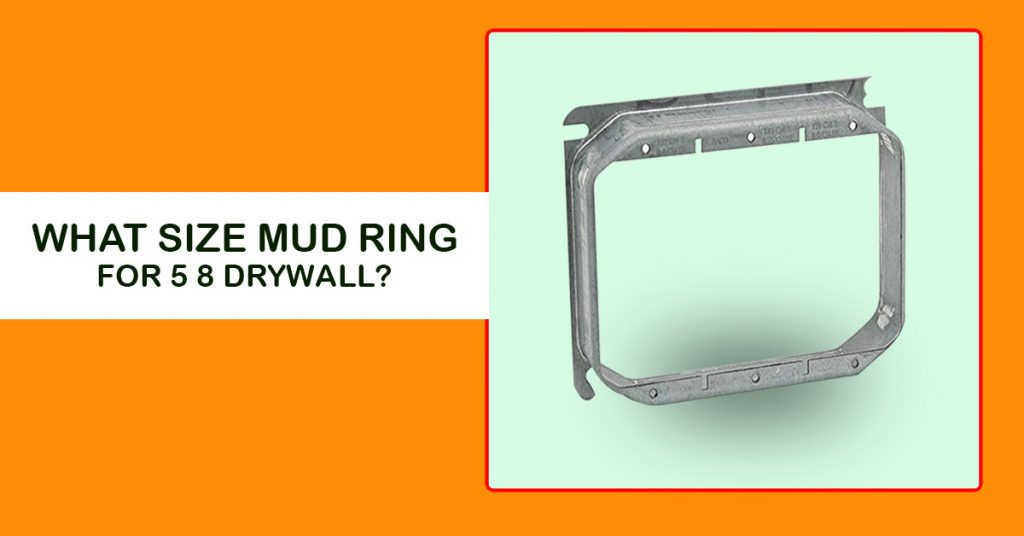Introduction
For those looking for soundproof rooms in new homes, the 5/8‘’ drywall is a no-brainer. It’s as thick as they can come in, making them great for walls and ceilings. What many struggle to figure out is the size of mud rings that can fit it.
What size mud ring for 5 8 drywall?
3/4-inch sized mud rings are the perfect fit for 5/8-inch drywall. Many would argue and go for 1/8-inch upsize plaster rings instead. Drywalls require slightly thicker mud rings to fit perfectly. Using a matching height of mud ring and drywall can create recesses.
Want to learn more? Stay until the end of this article to learn more about this topic.
Why Prefer 5/8” Drywall?
You should consider installing 5/8-inch drywall if you’re in the process of remodeling or building. These panels are specially used for walls. If you’re looking for drywall that requires a prescribed fire-resistant rating, this is the one.
Another reason why many prefer 5/8-inch drywall is that they are better at soundproofing. It also allows you to use R13 insulation in ceilings.
People usually go with 1/2-inch drywall for their walls and ceiling to cut costs. But it’s not as durable and sturdy as 5/8″. Builders prefer 5/8″ on the ceiling because its extra thickness makes it stiffer.
Installing 5/8″ covers all the inconsistencies usually found in houses framed with traditional lumbers.
Because they are finger-jointed most of the time, they give rise to several consistency issues. The 5/8″ drywall can cover the inconsistencies between the studs, giving you a better finish.
More thickness means that your drywall will lock out sounds with ease. This extra thickness also means the drywall has superior durability compared to 1/2″ drywall.
So if you’ve been looking to back away from using 5/8″ drywall, you’re missing out! The extra cost is worth investing in after drywall of this size.
What is an Electrical Mud Ring?
Mud rings are a cover for electrical boxes which provide an opening for outlets. The edges of the mud rings usually protrude outside the plaster or drywall.
It allows you to mount receptacles to the wall. Mud rings are installed on the mounted box and are generally used for commercial work.
Mud rings come in different sizes made for walls of different thicknesses. You can easily find the common ones ranging from 1/4 to 5/8 inches. Finding the 3/4 inch mud ring might take some effort as they are not widely manufactured.
Looking for durable mud rings that stiffly fit the wall? Check out these quality brands of mud rings that we recommend-
| Product-1 | |
| Product-2 |
They’re easy to install and won’t bother you for a lifetime once installed!
You should always buy mud rings that are easy to install and disassemble. You might need to fix your problematic double socket, and you’ll need to disassemble the ring.
Appropriate Mud Ring Size for 5/8 ” Drywall
Before choosing the appropriate mud ring size for 5/8-inch drywall, we’ve to consider its thickness. The 5/8-inch drywall is pretty thick drywall as we’ve learned in the previous segment. So to match its thickness, we’ll need a similar or thicker mud ring.
Many would suggest using the same size of mud ring as the drywall. That is, if you have 5/8-inch drywall, you should use a 5/8-inch mud ring.
In a perfect world, that might sound reasonable. But you’ll soon notice the flaw in this once you install your mud ring.
Using the same thickness of mud ring will put it slightly inwards by 1/8-inch. That much portion will be recessed to the wall surface.
On the other hand, going slightly thicker with 3/4-inch mud rings can fix the issue. The 1/8-inch gap won’t be existent anymore and it’ll fit the drywall perfectly. Similarly, if you’ve 1/2-inch drywall, you should buy 5/8-inch mud rings.
Keep in mind that it’s very difficult to achieve the perfect level of fitting. A lot of people want their mud rings to be flushed on the wall. This can be achievable but needs a lot of effort.
You’ll need to make fine cuts around the drywall to fit your mud ring. For that, we suggest using blades with a 10-14 TPI range. The 5/8″ is thick drywall and requires a high density of blades to cut.
FAQs
Question: Can you cover junction boxes with drywall?
Answer: You shouldn’t cover your junction boxes with drywall or anything else. Junction box covers should be accessible at all times for emergency situations. It’s where electrical circuits usually branch off in multiple directions.
Question: Should I place my junction box on the ceiling?
Answer: No, you shouldn’t do it. A junction box should be installed somewhere you can access it easily. That means somewhere near you where you can easily get in touch with it when necessary.
Question: Is plaster better than drywall?
Answer: Plasters provide a more durable finish than drywall. It also outperforms drywall in other areas such as insulation, soundproofing, fireproofing, etc. A very useful feature of plaster is that it’s mold resistant.
Summary
We answered your question about what size mud ring for 5 8 drywall.
Consult an expert before fitting your drywalls and mud rings. Take professional help to install mud rings if you’re not comfortable handling hardware.
Have a great day!
